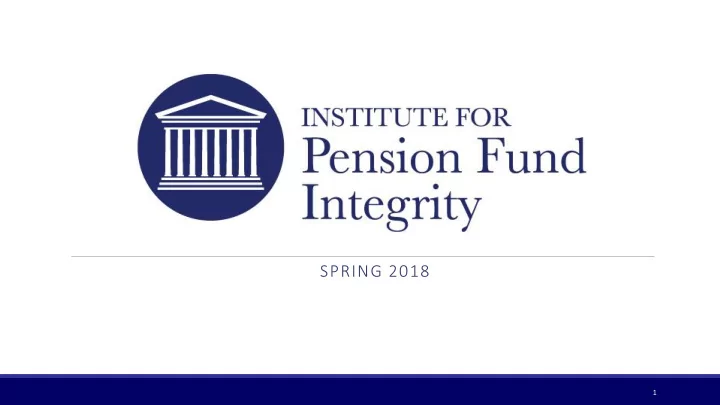

SPRING 2018 1
What is IPFI? The Institute for Pension Fund Integrity (IPFI) is a non-profit that focuses on getting politics out of public pension fund management and bringing market- based assumptions to the calculation of public pension unfunded liabilities. 2
What is the problem? Unfunded pension liabilities present a significant economic problem to state and local governments. As these governments continue to rack up increased unfunded liabilities, the burden of the liabilities falls on taxpayers and beneficiaries. Three of the major problems that are leading to higher than anticipated unfunded pension liabilities are: i. Politically – driven pension fund management ii. Longer life expectancy iii. High assumed rates of return 3
Politically-driven Fund Management Many public pensions are managed by politically appointed individuals who are beholden not just to plan beneficiaries, but also other stakeholders like voters and special interest groups Because of this, public pension managers have been increasingly pushed to use investments to make political statements: either more investing in specific funds, or divesting from negative industries (oil companies, tobacco companies, nuclear weapon/ defense industry manufacturers, gun manufacturers, etc.) It is estimated that the New York Common Retirement Fund would lose between $188 million to $302 million over five years if forced to divest from fossil fuels CalPERS missed approximately $8 billion in investment earnings due to its various divestments. Tobacco divestments alone cost the pension fund nearly $3 billion over 14-years Most of these stocks are incredibly well performing. Over the last 5 years: • Northrop Grumman’s stock has grown 489% • Boeing has grown 379% • Lockheed Martin has grown 352% It is time to get politics out of public pension fund management 4
Longer Life Expectancies State and local governments must also address the fact that people are living longer than current actuarial tables The mortality assumptions used for pension plans have not been updated in well over a decade — the most recent IRS-required mortality table was published in 2000, and the most commonly used mortality improvement scale was published in 1995 * As people live longer, they spend more years in retirement, raising the costs of providing their pensions 5 *Keener, Eric, and Matt Maloney. Society of Actuaries Finalizes New Mortality Assumptions . November 2014.
Life Expectancy Increases This chart, from the Society of Actuaries, shows the predicted life expectancy for males and females using different mortality assumptions published by the IRS 6 **Keener, Eric, and Matt Maloney. Society of Actuaries Finalizes New Mortality Assumptions . November 2014.
Longer Life Expectancies According to the Society of Actuaries, if pension sponsors were to use more recent mortality rates, liabilities could rise by 7% After updating mortality rates: ◦ New York raised annual contributions rates by 4% and 3.9% for the Employee Retirement System and Police and Fire Retirement System ◦ CalPERS lowered its funded ratio by 5% ◦ The Minnesota Teachers Retirement Association gained $600 million in projected liabilities 8
Unrealistic Rates of Return One major cause of the funding gap is the discrepancy between assumed and actual rates of return The median annualized 10-year rate of return for public pension plans in 2016 was 5.9%. * The median assumed rate was 7.5% Even small changes in rates can result in huge changes to unfunded liabilities 9 *Kilroy, Meaghan. "Cliffwater: U.S. State Pension Plans Returned a Median Annualized 5.9% over 10 Years." Pensions & Investments. October 02, 2017.
Unrealistic Rates of Return Pew estimated that investment underperformance in 2016 resulted in an additional $146 billion to the funding gap in state and local pension funds across the country Over the past 30 years, state and local governments have been turning to riskier investments for their pension funds As these governments adopt riskier portfolios, it is becoming increasingly difficult to accurately predict the rates of return 11
Case Study: Los Angeles Los Angeles (LA) has three pension funds Modeling a 1% Decrease in Rate of Return* totaling over $47 billion in assets $18,000 $15,446 LA assumes a rate of return of 7.25% $16,000 Liabilities (in millions) $14,000 $12,000 $10,000 $8,437 $8,000 $6,000 $4,000 $2,000 $0 6.25% 7.25% Rate of Return *City of Los Angeles Water and power Employees’ Retirement Plan. Financial Statements and Supplementary Information . Los Angeles, CA: October 30, 2017. *Los Angeles City Employees’ Retirement System. Comprehensive Annual Financial Report . Los Angeles, CA: December 5, 2017. 12 *Los Angeles Fire and Police Pensions. 2017 LAFPP Annual Report . Los Angeles, CA: November 20, 2017.
Case Study: Philadelphia The Philadelphia Municipal Pension Fund Modeling a 1% Decrease in Rate of Return* totals $4.357 billion in assets $7,611 $8,000 Philadelphia assumes a rate of return of $6,519 $7,000 Liabilities (in millions) 7.75% $6,000 $5,000 In 2016, the average return -3.2% $4,000 $3,000 $2,000 $1,000 $0 6.75% 7.75% Rate of Return 13 *City of Philadelphia Board of Pensions and Retirement. Financial Statements . Philadelphia, PA: June 30, 2016.
Case Study: New York City New York City has five separate pension Modeling a 1% Decrease in Rate of Return* funds with a total of $189 billion in assets $100,000 $91,946 and a funding ratio of below 70% $90,000 Liabilities (in millions) $80,000 NYC assumes a rate of return of 7% $66,280 $70,000 In 2016, the average return was 2% $60,000 $50,000 $40,000 $30,000 $20,000 $10,000 $0 6.00% 7.00% Rate of Return *Board of Education Retirement System of the City of New York. Comprehensive Annual Financial Report . New York City, NY: December 15, 2017. *New York City Police Pension Fund. Comprehensive Annual Financial Report . New York City, NY: December 15, 2017. *New York City Employees’ Retirement System. Comprehensive Annual Financial Report . New York City, NY: December 31, 2017. *Teachers’ Retirement System of the City of New York. Comprehensive Annual Financial Report . New York City, NY December 22, 2017. 14 *New York City Fire Pension Funds. Comprehensive Annual Financial Report . New York City, NY: December 12, 2017.
Recommend
More recommend